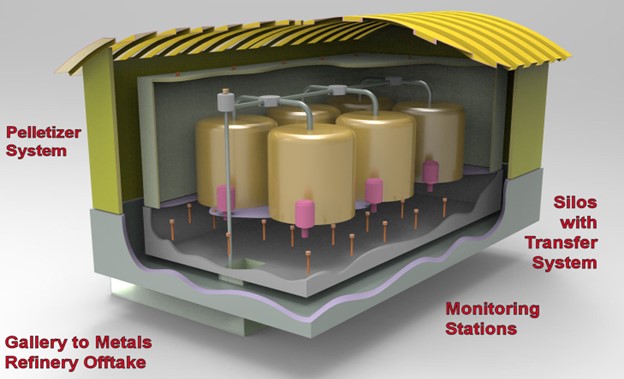Thorium Bank

Thorium “Bank” concept is a self-contained, fully automated facility for the secure storage with integrated encapsulation technology using proprietary methods being developed by the Thorium Energy Alliance.
The lack of a domestic nuclear fuel industrial base has been an overarching problem facing America’s nuclear energy sector. This country’s current ability to produce domestic nuclear fuel is “on the verge of collapse,” according to Dr. Rita Baranwal, the former Assistant Secretary for the Office of Nuclear Energy. According to the U.S. Energy Information Administration, U.S. operators of nuclear power reactors imported at least 88% of the annual fuel base in 2019. With the decline of domestic fuel production capacity, Congress has specifically targeted Uranium-233 and Thorium-232 as options for advanced reactors and commercial applications, as recently demonstrated in the 2020 Energy Act § 2001(b)(3).
To address this important issue, TEA and its partners are pioneering a novel technology and process to extract, refine, handle, and store thorium from U.S. mining wastes (the process is discussed more below). U.S. mining wastes alone contain an abundant supply of thorium to meet a large portion of U.S. nuclear fuel needs. Thorium extraction from these waste streams utilizes an economic and ecologically friendly model, whereby U.S. mining operations can off-load actinide-bearing wastes (such as from tailings ponds) to a centralized processing and storage entity. The source material thorium[1] is thereafter separated from the other mining wastes to be centrally managed. Moreover, this process has an additional benefit of significantly mitigating harms from any accidental ecological releases of the actinide-bearing mining wastes post-processing, because the thorium (a major waste constituent) has been removed.
While U.S.-based REE mining and refining capabilities have garnered much attention due to their critical material status, there remains the issue of thorium handling and disposal, which is almost always found with REE phosphate ores. The TEA has worked closely within the growing REE industry to provide a pathway to solve the actinide waste issue and allow for domestic production while developing a synergistic nuclear fuel supply chain for advanced reactors, such as the Molten Salt Reactor (MSR).


